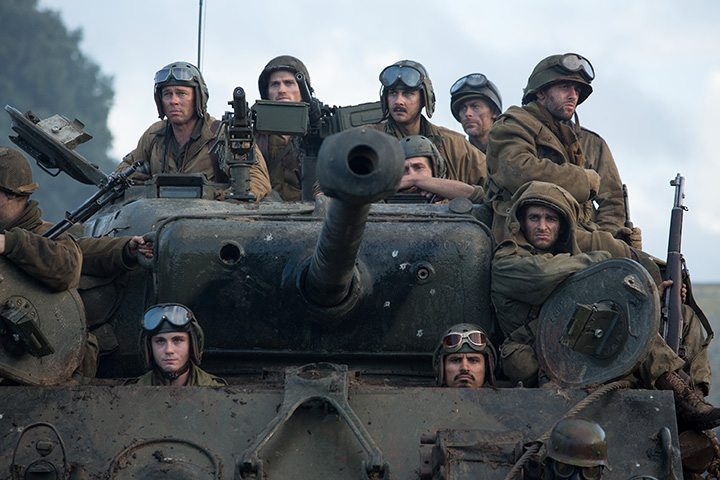
This review of the film Fury appears in the January/February issue of our new interactive iPad edition, along with other exciting bonus content. To learn more, check out the World War II magazine app in the iTunes app store. New subscribers interested in the iPad edition can subscribe in the HistoryNet shop. Current subscribers who wish to add a digital subscription in addition to print should contact our customer service team at 1-800-435-0715. For more help with subscriptions, please read our Digital Edition FAQ.
I’m glad a young friend—when you’re 90, somebody 64 is young—invited me to see Fury, the movie about GIs in Sherman tanks fighting in Germany in April 1945. In April 1945 I was a GI in Germany fighting in a Sherman tank, and I wondered how close the film gets to what I remember.
It gets darned close. Fury shows 88mm rounds and Panzerfausts hitting Shermans, and a mine blowing the tread off a Sherman. Coincidentally, I was in a Sherman hit by an 88 (it lodged in the engine compartment without exploding, and we had no casualties), and another Sherman that set off a Teller mine—two mines stacked, actually. And in April 1945 Germans shot my third tank with a pair of Panzerfausts.
Fury does show accurately how Shermans went into battle: spread out. And the film conveys the excitement of combat. The first time I was shot at in my life was that 88 round coming through the armor—totally mind-boggling. I could relate to the new soldier in the movie who six weeks before had been studying typing. Like him, I was as alien to the tank as the tank was to me. That part of the film is very well done. Perhaps the young soldier becomes a warrior a little too quickly, but I don’t have any trouble believing that men who fought through North Africa and Sicily and Europe, as the other characters in the movie have, would be hard men. I came into the fight in late 1944, and I wasn’t as hard as they are.
The movie also gets the emotions of combat right. I was in another Sherman with heavied-up armor when an 88mm crew a few hundred yards away fired at us. Their round hit but bounced off, which I’m sure surprised the Germans. Inside, the spot where that shot struck glowed red. The guy on the .30-caliber turret coaxial machine gun had seen where the round had come from. He laid a tracer onto the 88 and aimed our 76mm cannon and fired and that was that. I was watching through my periscope and saw the explosion and the bodies flying, the way they do in the movie. None of that affected me. You would have thought we had won the big game, yelling and screaming, until we reached the wreckage and saw the real horror of what had happened to those men. All of a sudden we were exhausted, same as the actors playing the crew.
I never experienced a one-on-one tank battle like the one in the movie, however. We fought at considerable distances. One of the few times we came upon a German tank we were taking a city, and down the street we saw the barrel of a Panther medium tank. We knew better than to try to fight it. We surrounded the Panther and called in a tank destroyer that had a gun capable of finishing it off.
In the movie a GI shoots a POW, and soldiers watching clap and laugh. I did see a mean little infantryman guarding some Germans hit and punch a prisoner, and when the prisoner ran that GI shot him. But no one clapped or laughed. In another scene the tank platoon takes a town. There’s a building full of what are supposed to be German soldiers who turn out to be just kids; well, we once drove into an enemy roadblock, and afterward we saw the “soldiers” who’d been defending it. They were just kids.
I did see things in the film to pick on. Some but not all of the violence is overdone. I don’t recall our fights lasting as long as the battles in the movie do, and when tanks road-march in Fury, they bunch up. Our battles were over in a flash, and the Third Army road-marched with around 50 yards or more between tanks—but then, we weren’t making a movie. When we threw a tread, our commander didn’t peremptorily say, “Fix it,” and walk away, as if you could jack up a 33-ton tank like a car with a flat tire; everyone on the crew threw in on the job. And I don’t remember a Sherman having as much room inside as the tank in the movie seems to.
Otherwise Fury gets it right, especially the sergeant Brad Pitt plays. When a young lieutenant orders him and several other sergeants to move out, he says, “The war’s not going anywhere, sir,” and lights a cigarette. That’s how some sergeants were. Those sergeants took no shit from anybody, even generals. They were the backbone of the army.
All in all Fury does a pretty good job of showing tankers at war, and also what a stupid waste war is. I hate to admit it but Fury took me back to a high point in my life, which is what makes war so horrible. We wind up making movies that can’t help but glamorize killing people because war is so damned exciting. —Lloyd Emerson served as a loader and radioman in the Third Army’s 11th Armored Division.




